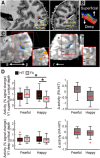Threat Anticipation in Pulvinar and in Superficial Layers of Primary Visual Cortex (V1). Evidence from Layer-Specific Ultra-High Field 7T fMRI
- PMID: 31694815
- PMCID: PMC6901684
- DOI: 10.1523/ENEURO.0429-19.2019
Threat Anticipation in Pulvinar and in Superficial Layers of Primary Visual Cortex (V1). Evidence from Layer-Specific Ultra-High Field 7T fMRI
Abstract
The perceptual system gives priority to threat-relevant signals with survival value. In addition to the processing initiated by sensory inputs of threat signals, prioritization of threat signals may also include processes related to threat anticipation. These neural mechanisms remain largely unknown. Using ultra-high-field 7 tesla (7T) fMRI, we show that anticipatory processing takes place in the early stages of visual processing, specifically in the pulvinar and V1. When anticipation of a threat-relevant fearful face target triggered false perception of not-presented target, there was enhanced activity in the pulvinar as well as in the V1 superficial-cortical-depth (layers 1-3). The anticipatory activity was absent in the LGN or higher visual cortical areas (V2-V4). The effect in V1 was specific to the perception of fearful face targets and did not generalize to happy face targets. A preliminary analysis showed that the connectivity between the pulvinar and V1 superficial-cortical-depth was enhanced during false perception of threat, indicating that the pulvinar and V1 may interact in preparation of anticipated threat. The anticipatory processing supported by the pulvinar and V1 may play an important role in non-sensory-input-driven anxiety states.
Keywords: 7 tesla fMRI; V1 cortical layer; fearful face; pulvinar; threat perception.
Copyright © 2019 Koizumi et al.
Figures




References
-
- Brainard DH (1997) The psychophysics toolbox. Spat Vis 10:433–436. - PubMed
Publication types
MeSH terms
LinkOut - more resources
Full Text Sources
